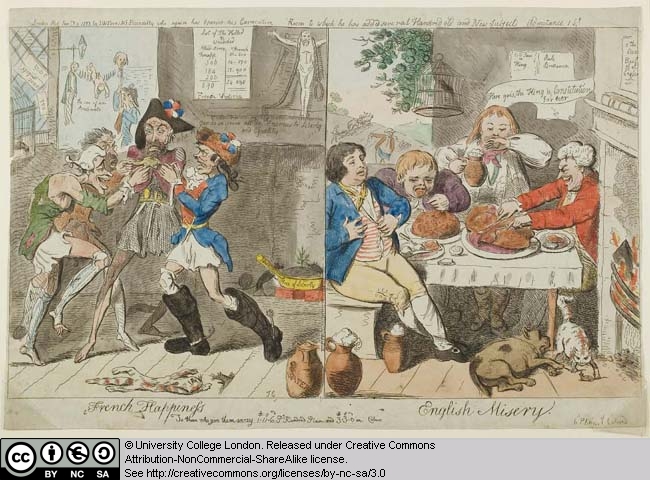8 French Happiness, English Misery

Isaac Cruikshank (1756
– 1811)
French Happiness,
English Misery , 1793
Etching with
hand-colouring
Published by S. W.
Fores, No. 3 Piccadilly,
In this English caricature, Cruikshank contrasts the
Frenchman’s savage situation during the Revolution to the peaceful and
plentiful circumstances of the Englishman. On the left, four famished
Frenchmen, dressed in tattered clothing, are tugging at a single frog. Images
of death and violence surround them, in particular the crucifix that now serves
to hold a rope and a dagger, while through the window one can make out a man
hanging by his neck and a head at the end of a pike. On the ground a ‘Tree of
Liberty’, a symbol often used in revolutionary festivals, is gnawed at by mice.
A cat dying of hunger reaches for a mouse but is too weak to catch it, while a
bird dies in its cage. Cruikshank contrasts this scene with the four healthy
Englishmen to the right. Even the animals on the ground are well fed and plump,
as the men at the table devour legs of ham or beef. Through the window, the
prosperous English countryside, lush with vegetation, can be seen.
The method of dividing a print into two sections and
contrasting the oppressed, starving Frenchman to John Bull or Jack Roast
Beef was popular during this period. It was important to the governing classes
that the people of
Licensed under the Creative Commons Attribution Non-commercial Share Alike 3.0 License
This resource has been released as an open educational resource (OER) on a Creative Commons 'Attribution Non-commercial Share Alike' license. This means that once downloaded, content can be modified and improved to complement a particular course. This requires, however, that improvements are recycled back into the OER community. All content present at the time of download must be accordingly credited and, in turn, novel content must be appropriately licensed.